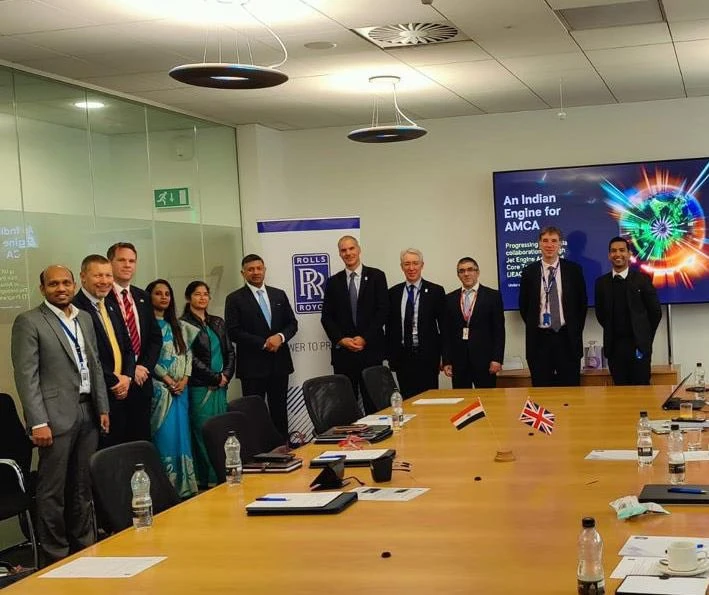Rolls Royce has met with a team from the Defense Research and Development Organization (DRDO) to discuss the engine development for the Advanced Medium Combat Aircraft (AMCA), the fifth generation fighter aircraft project for the Indian Air Force (IAF). Two tweets on October 7th reveal that Dr. Vikram Doraiswamy, the Indian High Commissioner to the United Kingdom and Ms. Chandrika Kaushik, the Director General of the DRDO, attended a presentation at the Rolls Royce facility near Bristol in the UK. One of the images shows that the AMCA Engine was the topic of the presentation. The image has a poster with the following words – development, collaboration, and Advanced jet engine core.
The India unit of Rolls-Royce expressed interest in cooperating with India to co-develop and manufacture engines for the AMCA programme in 2021.
Kishore Jayaraman, president of Rolls-Royce India and South Asia, told The Print that the Intellectual Property (IP) rights for the 110 KN engine would be owned by India if a partnership is created.
In the future, India will need the IP to modify and upgrade its engines. Intellectual property ownership assures that engines can be sold to other parties and that the United Kingdom cannot veto India in the event of geopolitical or competitive issues.
Rolls-Royce believes it can be a successful partner for India’s AMCA engine production, encompassing co-creation, co-development, and co-manufacturing. Jayaraman said it is congruent with India’s indigenous design and production push and the Atma Nirbhar approach.

According to Jayaraman, Rolls Royce is committed to the co-creation concept because, ultimately, when organisations co-create, they generate intellectual property locally. The supply chain and services model may be created when a product is developed and produced in India. According to him, this fosters a new environment in the Indian aviation industry.
Three engine firms offer engine partnership
India is in discussions with Rolls-Royce, French company Safran, which makes engines for Rafale fighter, and American company General Electric (GE), which supplies engines for Light Combat Aircraft ‘Tejas, about a possible arrangement to build jet engines in India.
Rolls-Royce and Safran are the leading contenders; however, Safran has not yet met the requirements for Rafale fighter engines. The offset requirement for the Rafale contract involves the transfer of aircraft engine technology. The Rafale jet sale called for the transfer of knowledge for the development of an indigenous LCA engine, but Safran has not yet carried it out and has been called out by the government watchdog, the Comptroller and Auditor General of India (CAG)
According to past reports, Rolls Royce has offered a Eurojet EJ-200 variant with 110-120KN thrust. The SAFRAN-DRDO joint venture is intended to include a comprehensive ToT and will be based on the M88 engine base. Rolls Royce has an advantage over Safran as it has already developed an engine above 90 KN and is known as a reliable engine maker along with General Electric and Raytheon unit Pratt & Whitney. But Rolls Royce has denied spare parts to India before due to sanctions, especially in the time of dire need.
Even more troubling to the Indian establishment is the United States government’s fickleness on technology transfers. Recently, American interest in the fighter engine programme has been reignited. In October 2019, the India-US Defense Trade and Technology Initiative (DTTI) partnership on jet engine technology was postponed due to American unwillingness to share core or hot engine technology. The collaborative working group on jet engine technology was eventually dissolved within the DTTI framework. However, in the initial phase of the AMCA project’s development, the GE-414 engine will be acquired and mounted.
Russia is the only other notable producer of engines; however, their engines are inefficient, and Rosoboronexport, the Russian arms export agency, overcharges at every level.
The visit by DRDO personnel to the Rolls Royce facility does not necessarily presage an agreement, given that the development of the AMCA 110 KN engine is not anticipated to commence until 2030. Depending on the ultimate cost of the engine project, a combined IP is also being explored in addition to an Indian-only IP.
The importance of the engine IP
The intellectual property of the engine is a vital element of India’s engine development plan since the engine can be changed to suit the LCA Mk1/1A re-engine plans and LCA Mk2/ Indian Navy’s Twin Engine Deck Based Fighter (TBDEF) requirements.
About half of the needed engines for the LCA Mk1/ LCA MK 1A programme have been ordered from GE for its GE-404-IN20 84KN engines. The IP will allow India to scale up the Kaveri engine to satisfy the needs of the LCA Mk1/1A projects and the future development of the LCA Mk2/TBDEF, which would initially utilise the GE-414 engine with a thrust rating of 98KN. The other two competitors for the GE-414 are the Rolls Royce EJ 200 engine and the Safran M-88- 4 engine.
The GTRE GTX-35VS Kaveri is an afterburning turbofan developed by the DRDO’s Gas Turbine Research Establishment (GTRE).
